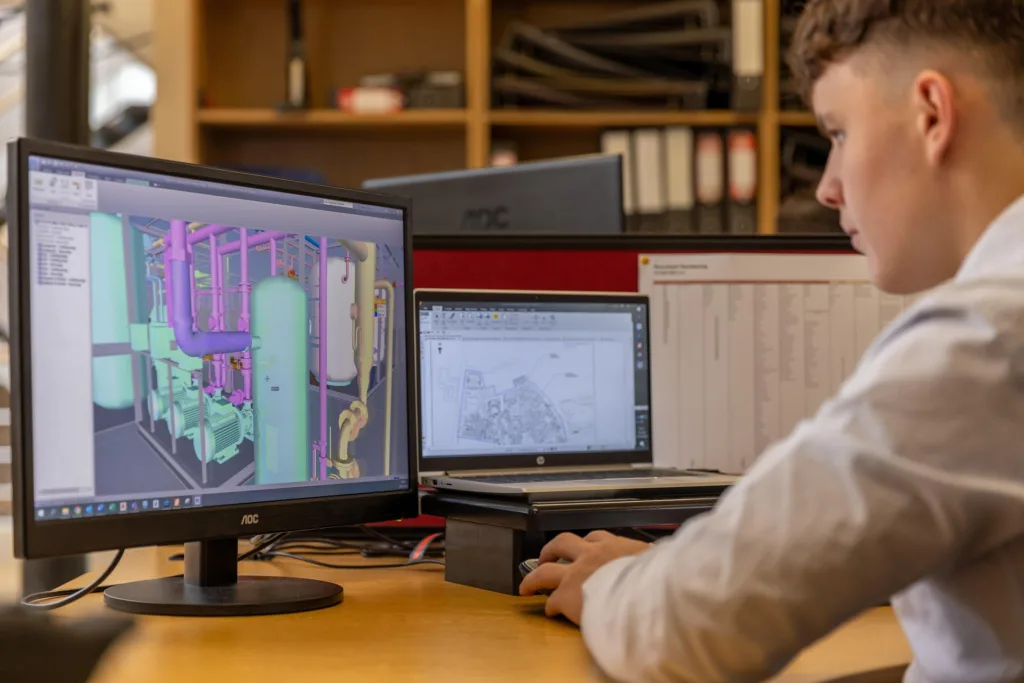Within the modern workforce, productivity is the difference between companies that lead the market and those that struggle to keep pace. For industries such as construction, engineering and large scale infrastructure – productivity is not simply about speed but about precision, safety and sustainability. Technology has become the core driver of these goals in some businesses. From digital collaboration tools to artificial intelligence and advanced workforce management systems, technology is transforming how companies deploy and maximise their talent.
At Aureol Global Connections, where our mission is to bridge global skills with local demand, we see first-hand how innovation is changing not only the way projects are delivered but also how skilled workers are recruited, supported and retained. Those are the businesses that are thriving and among our most trusted partners.

The New Era of Workforce Productivity
Historically speaking, productivity improvements came from process optimisation, training or increased staffing. Today, technology is providing exponential leaps forward by reducing and identifying inefficiencies, automating routine work and enabling teams to achieve more with less.
A recent McKinsey study estimated that digital tools alone could raise productivity in construction by up to 15 percent. For sectors heavily reliant on skilled labour, these gains can translate into millions saved, faster project delivery and a safer, more motivated workforce.
Key Ways Technology is Enhancing Workforce Productivity
1. Digital Collaboration Platforms
Remote and hybrid working models have created new challenges for employers, but digital collaboration platforms like Office 365, Google Workspace, Slack and Asana have provided effective solutions. These platforms centralise communication, streamline project management and reduce the delays caused by email backlogs.
In construction projects for example, digital blueprints and cloud-based collaboration ensure that engineers in London, architects in Dublin and skilled site workers on the ground are always working from the same version of the plan. Errors are minimised and decisions happen faster.
2. Artificial Intelligence and Predictive Analytics
AI is no longer a futuristic buzzword. Today it is actively supporting workforce productivity by forecasting project timelines, identifying risks before they escalate and allocating resources more effectively.
Predictive analytics for example, can analyse historical data from similar projects and forecast labour needs, equipment use, or potential supply chain disruptions. For companies hiring skilled labour, this means workers are deployed at the right time and in the right numbers, avoiding costly downtime.
3. Workforce Management Systems
Managing a global workforce is complex. Modern workforce management systems integrate scheduling, compliance tracking, performance measurement and payroll into a single platform.
For employers this means fewer administrative hours spent on paperwork and more time focusing on strategic planning. For workers, it ensures clear schedules, accurate pay and better transparency which are all factors that drive morale and productivity.
At Aureol Global Connections, we help companies source skilled labour internationally and technology plays a key role in ensuring compliance with visa requirements, health and safety standards and employment regulations. For us we can cross reference databases across our businesses, make key hiring decisions and track all aspects of the employment process digitally, rather than via paperwork offline.
4. Automation and Robotics
Automation is reshaping the workplace across industries. In construction, drones are used to survey sites more quickly and accurately than human teams. Robotics are sometimes able to assist with repetitive or high-risk tasks reducing accidents and speeding up delivery.
Rather than replacing human workers, these technologies complement them. Skilled labour remains essential for complex problem-solving, supervision and creative design but with automation handling routine tasks, skilled professionals can focus on higher-value work.
5. Mobile Technology and On-Site Productivity
Mobile technology has become indispensable. Smartphones and tablets allow supervisors and workers to access project data, report issues and communicate in real time while on-site. GPS and geofencing applications ensure accurate tracking of equipment and workforce location, reducing losses and downtime.
For international workers, mobile platforms also offer translation tools, training modules and cultural integration resources, ensuring smoother adaptation and higher retention rates.
6. Training and Skills Development through Technology
Technology is also revolutionising how workers are trained. Virtual Reality (VR) and Augmented Reality (AR) create immersive training environments where workers can practice complex procedures in a safe, controlled setting.
For instance, a crane operator can train on a VR simulator, gaining experience and confidence without risk to equipment or colleagues. Similarly, AR tools can overlay digital instructions on real-world equipment, guiding workers step-by-step and reducing errors.
Continuous learning through online platforms also means workers can upskill without leaving their job site, making training more accessible and ongoing.
7. Data Driven Decision Making
The modern workplace produces an enormous volume of data. When properly harnessed, this data provides invaluable insights into worker performance, project efficiency and resource allocation.
For managers, dashboards and reporting tools translate complex data into actionable strategies. For workers, performance analytics can provide real-time feedback and recognition, motivating teams to continuously improve.
The Human Factor: Balancing Technology and People
While technology is enhancing productivity, the human element remains at the centre of success. Skilled workers are the foundation of every industry and no level of automation can replace their expertise, adaptability and problem-solving capabilities. Nor should it – trusting AI with such intricate and important tasks can be catastrophic without humans around to control and implement the technology correctly.
The challenge and the opportunity lies in balancing technology with the human workforce. Employers who embrace digital tools while investing in their people will achieve the strongest results. This means creating environments where workers feel empowered rather than replaced and where technology serves as a support system rather than a barrier.
Why This Matters for Employers in the UK and Ireland
The demand for skilled labour in the UK and Ireland continues to outpace supply, particularly in construction and engineering, but across other industries too. Technology can help close this gap by maximising the productivity of every worker, but employers also need access to reliable, skilled talent.
At Aureol Global Connections, we specialise in sourcing and deploying international skilled workers to meet this demand. By combining human expertise with technological innovation, employers can not only bridge skills shortages but also gain a competitive advantage in efficiency, quality and delivery.

In Summary
Technology is not replacing the workforce, it is enhancing it. Digital collaboration, AI, automation, mobile platforms and data-driven systems are redefining how projects are delivered, how workers are supported and how businesses grow.
For employers, embracing technology is no longer optional. It is the key to unlocking greater productivity, retaining skilled workers and achieving long term success in competitive global industries.To speak to us about bringing in skilled labour to help you meet demand then please do get in touch with us here

